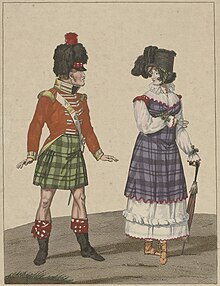Scottish Blue Bonnets
Posted by Charles MacGregor on Apr 28th 2019
Originally Published April 2012. Written for The Celtic Croft by Charles MacGregor of MacGregor Historic Games.
Scottish Blue Bonnets

Some time ago I was discussing the topic of Scottish men's head wear and a fairly knowledgeable person I was talking to said: "The only references to headgear I've found for pre-1600 Highlanders was to helmets, and there are at least one or two references that specifically describe Highland men as not wearing hats."
However, we do know that a simple form of the blue balmoral or "bonnet" seems to have been common at least in the Lowlands by the early 1600's. The crown of this hat tended to be wider across than a modern balmoral, and did not yet have the red and white "dicing" around the headband and there was no woollen ball or "toorie" on the top. These seem to have be common enough to have even inspired a song "Blewe Cappe," which appeared in the music collection called the "Skene Manuscript" which is believed to date to about 1620. In the song a woman is saying she'll have no English or French or Spanish man, only a Scotsman -"A blue cap for me!" That seems to pretty clearly suggest that by 1620 early blue bonnets, or blue hats of some kind, had been common long enough among some classes of Scots to have become a bit of a stereotype.
Blew Cappe
Come hither the merri'st of all the nine,
Come sit thee down by me, and let us be jolly;
And in a full cup of Apollo's wine
Wee'll drowne our old enemy, mad melancholy;
Which, when wee have done, wee'll betweene us devise
A dainty new ditty, with art to comprise;
And of this new ditty the matter shall be,
Gif ever I have a man, Blew cap for me.
There lives a blithe lasse in Falkeland towne,
And shee had some suitors, I wot not how many;
But her resolution shee had set downe
That shee'd have a Blew cap, gif ere she had any.
An Englishman, when our good king was there,
Came often unto her, and loved her deare:
But still she replide, "Sir, I pray let me be;
Gif ever I have a man, Blew cap for me."
These sundry suitors of several lands
did daily solicite this lass for her favour,
And every one of them alike understands,
That to win the prize, the in vain did endeavour:
For shee had resolved (as I before said)
To have bonny Blew cap, or else dee a maid.
Unto au her suppliant still replide she,
"Gif ever I have a man, Blew cap for me."
At last came a Scottish man (with a blew cap),
And he was the party for whom she had tarry's,
To get this blithe bonny lasse 'twas his gude hap.
They gang'd to the kirk, and were presently marry'd":
I ken not weel wether it were lord or leard,
They caude him some sike a like name, as I heard;
To chuse him from all she did gladly agree,
And still shee cry'd, "Blew cap, th'art welcome to mee."
Falkland is a Lowland town, so it may be less likely the "blithe lass" was pining for a Highlander. The line "when our good king was there," may date the lyrics to some time after 1617 when James VI visited Scotland and spent a short time hunting at Falkland. There was also a royal castle at Falkland. In this context, the song makes even more sense since a town with royal palace would be expected to see more than it's fair share of foreigners -at least when the king was present.

